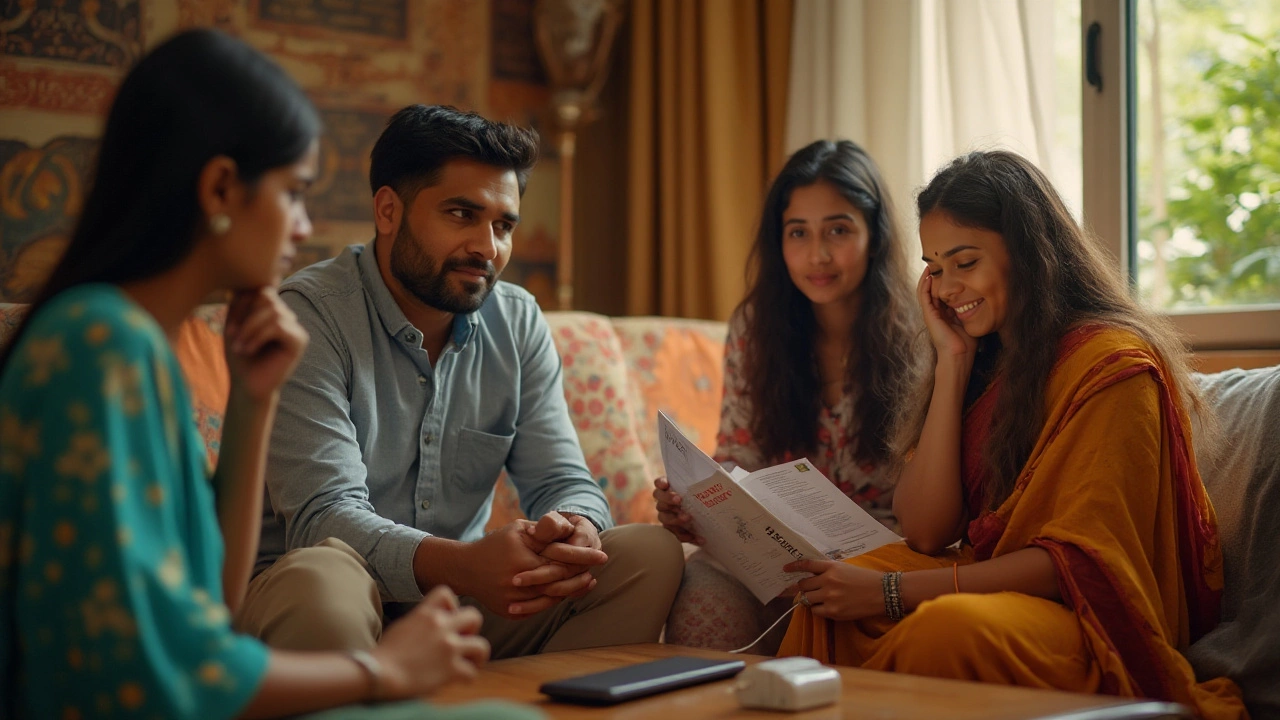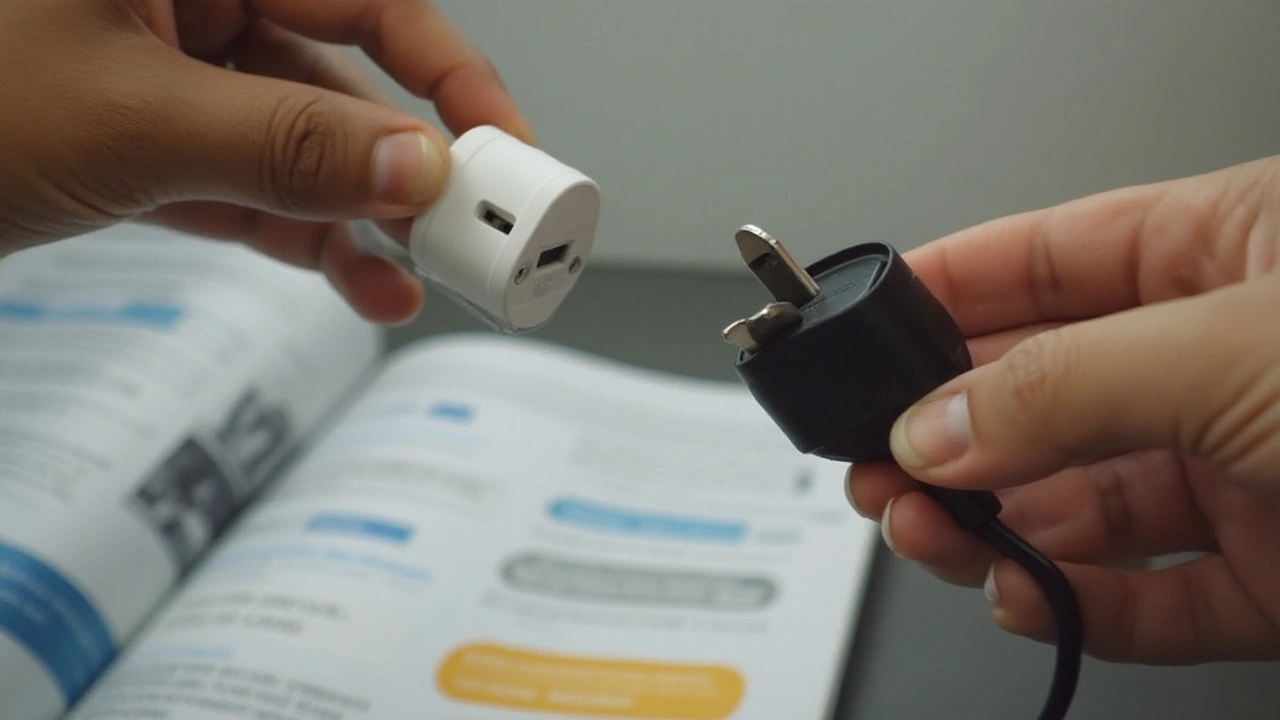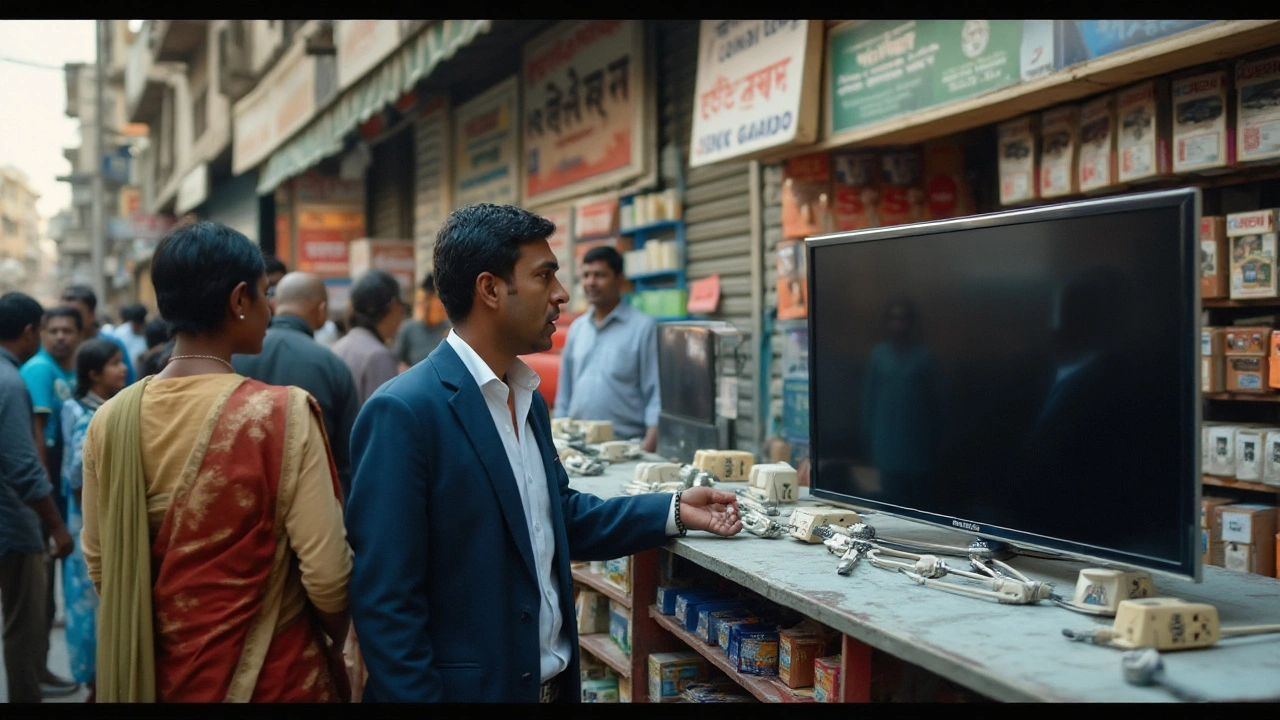
If you've ever thought about bringing a TV from the US to India, there's more to consider than just the price tag. The journey from one country to another involves more than packing it safely—the technical side of things can be a bit of a puzzle. Differences in electrical voltage, plug styles, and signal formats all come into play. Whether it's about family relocations or finding a better deal overseas, understanding these factors will make sure your move is as seamless as it gets. Let's dive into this cross-continental tech challenge and unlock a smooth viewing experience across borders.
- Understanding Voltage Differences
- Plug and Socket Compatibility
- Broadcast Standards Explained
- Adjusting TV Settings for International Use
- Using Voltage Converters and Adaptors
- Considerations for Smart TVs and Streaming
Understanding Voltage Differences
When bringing a TV bought in the US to India, it’s crucial to address the voltage discrepancy between these countries. The United States operates on a 110-120V electricity supply, while India uses a 220-240V system. This fundamental difference is one of the first obstacles anyone looking to use US electronics, including TVs, may face. Without a proper understanding and adjustment, an unsuspecting user might find themselves with a non-functional device or, even worse, a smoking, sparking hazard. The importance of investigating voltage compatibility before plugging in cannot be overstated because high-voltage mismatches can lead to significant damages.
These differences in voltage aren't just technical formalities—they're rooted in both historical developments and regional standards. In the early days of electricity, various regions opted for different voltage standards, and over time, these standards solidified. The North American choice for 120V systems, compared to the 240V standard in use across much of Europe and Asia, including India, is primarily based on the decision made by early power companies and has evolved due to local needs and circumstances. For someone planning to have a US TV in India, this means considering voltage converters or dual voltage TVs explicitly designed to handle various power inputs.
Solutions to Navigate Voltage Mismatches
Most modern televisions, especially smart TVs, may be built with input voltage flexibility, but it's always wise to confirm this by checking the label on the TV or the user manual. Some devices come with in-built transformers that easily adapt to both 110V and 240V. However, not every device has this capability, so investigating this feature before usage is critical. If your TV does not support 220V natively, using a step-down voltage converter might be necessary. These converters can safely adapt the Indian voltage supply to the American standard, allowing your electronics import to function properly and without incident."Using an appropriate voltage converter is not just about functionality—it's about safety," advises John Smith, an electronics expert from the renowned Gadget Tech website. "Before setting up, ensure your converter has adequate wattage capacity to handle your TV’s power requirements."
Convertors are rated by wattage, and getting one that matches your TV’s power consumption is vital. A step-down convertor that underperforms could lead to overheating or insufficient power supply, whereas overestimating can be inefficient and more costly. Understanding the wattage your TV requires and selecting a converter with a slightly higher wattage rating can help mitigate risks.
In summary, crossing borders with TVs means crossing electrical systems, and voltage differences are a prime piece of this puzzle. Handling these requires careful consideration, a bit of homework, and sometimes a little extra hardware, but with the correct setup, your US TV will bring India’s vibrant culture to life on its screen, right in your own living room.
Plug and Socket Compatibility
When it comes to setting up your American TV in India, it is essential to consider the differences in plug and socket designs between the two countries. The United States typically uses type A and type B plugs with voltages around 120V, whereas India employs type C, D, and M plugs with a standard voltage of around 230V. This discrepancy means that plugging your US TVs directly into an Indian socket without the proper equipment can be hazardous. This voltage difference can lead to potential damage to your device or even personal harm.
The solution lies in utilizing plug adapters and perhaps a voltage converter. Plug adapters are easily accessible and affordable; they allow your TV's plug to fit into the Indian sockets without altering the voltage. However, there is more to take into account beyond just fitting a plug into a socket. The electrical current and what it carries is distinctly different, which means a voltage converter is often necessary to adjust your device's power supply from 230V to the 110-120V it was designed for. This added precaution ensures that your electronics operate effectively and safely in an Indian environment.
"Travel adapters alone help with the plug shapes, but voltage converters are crucial to adapt power levels in cross-border appliance usage," explains Rahul Narayan, an expert in global electronics compatibility.
Types of Adapters and Converters
When shopping for an adapter or converter, consider the requirements of your television set. Lightweight and simple travel adapters might serve short-term purposes, especially if you plan to use your electronics import temporarily. Yet, for a permanent setup, multi-voltage adapters or heavy-duty transformers are recommended. These devices not only accommodate the physical plug shapes but also correctly balance the voltage, making sure your TV compatibility concerns are addressed comprehensively.
In some instances, newer TVs incorporate universal power supplies, which automatically adjust to varying voltages. If you are unsure whether your current TV model includes this feature, it’s wise to check the documentation or the manufacturer's website before relying on this function. For those relocating frequently, owning a universal adapter or converter, which can be used in multiple countries, is a practical investment ensuring you do not encounter similar issues in the future. Remember, ensuring compatibility at the start can spare you from future inconveniences and ensure a seamless entertainment experience worldwide.

Broadcast Standards Explained
Televisions across the globe due to varying broadcast standards often differ based on regional technological adoptions. The two most prominent systems, PAL and NTSC, highlight the primary challenge American televisions face when introduced to the Indian market. The US predominantly employs the NTSC standard, while many other countries, including India, operate via the PAL standard. These systems stand as the backbone for how images and sound are transmitted onto your screen, and interestingly, it's not just the image that's affected – everything from colour fidelity to screen refresh rates is encapsulated in these systems.
NTSC, short for National Television System Committee, has been the method of choice in North America. It boasts a refresh rate of 60Hz paired with 525 lines which provide a unique visual experience. However, PAL, which stands for Phase Alternating Line, delivers 625 lines with a 50Hz refresh rate. This means PAL systems tend to offer a finer image resolution at the possible expense of occasional flicker depending on various visual factors. Converting between these formats is often easier said than done, as it can lead to signal distortion or color misrepresentation.
Many modern televisions offer multi-system compatibility, rendering this issue moot for newer models. They automatically adjust to different regional setups. In fact,
"In today's interconnected world, technology's evolution ensures that incompatibility is rarely a dead-end obstacle. Rather, it's a challenge overcome by adaptability," suggests Rajesh Kumar, a tech analyst from Sydney.Incorporating multi-system capabilities allows users the flexibility of a seamless transition between broadcast standards.
It's worth noting that influential global tech brands are actively pushing towards universal television systems. Their aim resides in a standard platform that dissolves these barriers and creates a streamlined process for international television transactions. If you own one of these advanced models, transitioning your TV's compatibility from the US standard to India's requires less hassle.
In terms of practical solutions for older televisions, external signal converters are available in the market. These devices convert the NTSC signal into a PAL format, although they tend to reduce image quality somewhat due to altering the signal path. For those prioritizing visual clarity, weighing the pros and cons of investing in such converters holds importance. However, for viewers content with basic functionality, employing these converters is a viable avenue.
Adjusting TV Settings for International Use
When embracing the idea of using a US TV in India, navigating through the technical labyrinth of settings becomes inevitable. At the heart of the challenge lies the issue of broadcast standards. The US predominantly uses the ATSC system for transmitting television signals. Conversely, India relies on the DVB-T system. These standards are not interchangeable, meaning a direct plug-and-play approach won’t yield your favorite channels serenading you from the screen. Many modern TVs, however, come with built-in tuners that can handle multiple standards. Delving into your TV's manual or settings can reveal if it's indeed a multi-system miracle, ready to embrace Indian airwaves. But if adaptability is not an option, external tuners compatible with local broadcasts could be the saving grace you need.
Power systems present another labyrinth where vigilance is demanded. While voltage and plug compatibility can be addressed with the right converters and adapters, exploring the intricacies of the TV’s input settings is a necessity. Most American TVs are set to automatically detect input voltages compatible within a 100-240V range. This is a relief when tuning into their features here in India but double-checking can save you from unexpected calamities. Should you find flickering screens or odd behavior, adjusting video settings like picture modes, color formats, and refresh rates to align with local content can be crucial for smooth operation. It's worth noting, as highlighted by experts from CNET, ‘Understanding each component allows for a seamless transition between regions’.
Smart TVs bring their own realm of considerations. Here lies the need for conniving the correct regional settings within the TV's software. Some TV models tie the functionality and app availability to geographic locations. Therefore, adjusting the location settings can unlock the complete potential of smart features. However, some apps remain bound by international licensing agreements, presenting a puzzle for the determined. Turning to VPN services can occasionally blur these lines, giving access to otherwise locked streaming services and applications. Yet, it's wise to stay informed about the legalities tied to such methods. A universal truth in the realm of technology - knowing the right tweaks and adjustments transcends borders.

Using Voltage Converters and Adaptors
When you bring a TV from the US to India, adjusting to the local power supply becomes a crucial step. The first hurdle is understanding the electrical voltage difference. The United States typically operates on a 120-volt, 60 Hz electrical grid, while India uses a 230-volt, 50 Hz system. This disparity means that your beloved TV might not be able to plug directly into the Indian sockets without a hiccup. Here, stepping into the world of voltage converters and adaptors can be your saving grace. These nifty devices help bridge the gap, ensuring your imported TV handles the higher voltage found in Indian outlets without turning it into an unplanned fireworks display.
One cannot stress enough the importance of selecting the right converter. A standard voltage converter is engineered to transform the 230 volts from Indian sockets down to 120 volts, making it safe for your US television. The variety of converters range from basic ones for small electronics to more robust models that can support higher wattage devices, which a television certainly is. An often overlooked piece of advice from electronics enthusiasts is to opt for a voltage converter that is rated slightly above your TV's wattage consumption. This precaution guards against any potential damage, especially when the TV draws additional power during startup. According to the renowned tech magazine Wired, “Investing in a quality converter can extend the life of your electronics in a foreign land.”
Another aspect to keep an eye on is compatibility with plug types. Plugs in the US are generally Type A or B, which won't fit into India's Type C, D, and M outlets. Adaptors specifically designed for this purpose are readily available in local markets or online stores. These adaptors don't alter the voltage but merely allow the plug to fit into the socket. It's crucial to pair a plug adaptor with a voltage converter unless you're using a device that supports dual voltage operation, which isn't usually the case for televisions. Plug and socket compatibility is often the overlooked element, leading to logistical headaches that are easily avoidable with little pre-trip planning.
"Ensuring that electronic devices are compatible with local power requirements is the hallmark of a smart traveler," advises Tech Advisor, a respected source in the electronics field.
A smart consideration can be an auto-transformer, which is a type of converter that can handle both step-up and step-down operations. This means it can adjust to both US and Indian voltages, offering added convenience for frequent travelers. It may come with a heftier price tag, but the investment pays off as it reduces the hassle of multiple purchasing adaptors and converters when traveling elsewhere around the globe. Each adapter is generally limited to around 1650 watts. Hence, eyeballing not just the wattage label on your TV, but also understanding the demands of your device can save the day.
In case your TV is of the newer smart category, it’s wise to delve into its specifications. Many modern televisions are designed with built-in voltage converters, eliminating the need for an external unit. If your new purchase boasts support for global voltage, you're in luck! Make sure to check if global television use is mentioned in the product listing or user manual. Despite the availability of this feature on some models, it's crucial not to assume without checking; it could spell the difference between flawless operation and costly repairs.
Considerations for Smart TVs and Streaming
Let’s talk about the modern wonders of Smart TVs. A Smart TV bought in the US could indeed bring entertainment delight if thoughtfully integrated into an Indian setting, but it does come with a few considerations. Firstly, the regional content availability can be quite different. Streaming services like Netflix, Hulu, and Disney+ vary their libraries based on location due to licensing rights. For instance, you may find that certain shows you enjoyed overseas are not accessible once you plug in your device in India. Additionally, the app compatibility might pose a challenge, as not all apps offered on US Smart TVs will adapt seamlessly to the Indian network setups, potentially requiring additional subscriptions or VPN services.
Depending on the model, language and region settings might need to be manually adjusted to optimize streaming performance. One fascinating detail is the reliance on internet connectivity. Smart TVs thrive on strong broadband connections, and the average internet speed and reliability can differ significantly between countries. It’s practical to have a plan for improving connectivity if needed. Customer support is another angle to consider; most manufacturers provide region-specific help, so any queries might need routing through US customer service if the TV was originally from there.
When it comes to streaming quality and compatibility, firmware updates are a method to keep the software up-to-date, enhancing performance and security. However, these updates can be region-specific, which might lead to discrepancies with locally sourced content. With Smart TVs becoming more like computers, keeping your smart device updated ensures a superior viewing experience. In terms of infrastructure, consider acquiring a Chromecast or Fire Stick for added flexibility, providing a bridge for content discrepancy problems.
"A Smart TV can be your best friend or worst frustration outside its birthplace," notes Jessica Fuller, a leading tech analyst. Understanding the service and platform disparities is pivotal for a smooth experience.All these intricacies shape how a TV imported from the US will adapt to its new Indian environment. So, before making the leap, it's wise to weigh these factors and equip yourself with solutions, ensuring your multimedia adventures aren't disrupted.